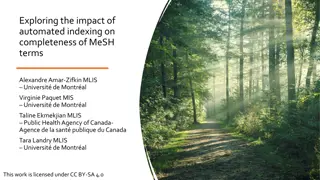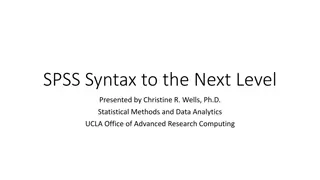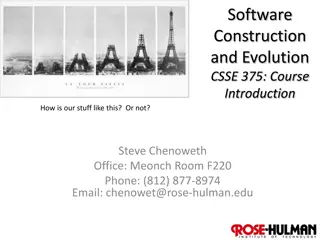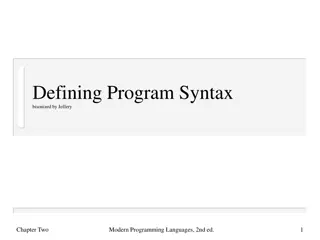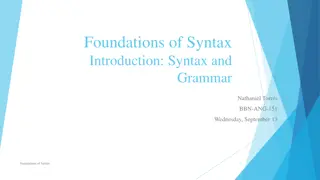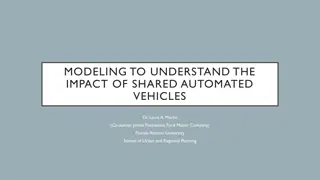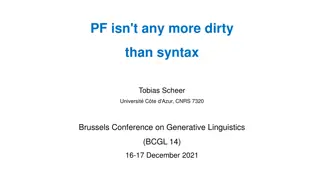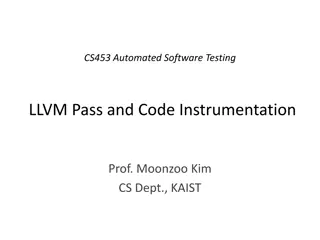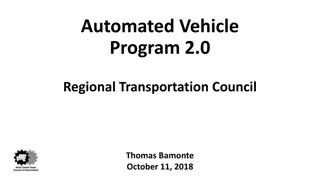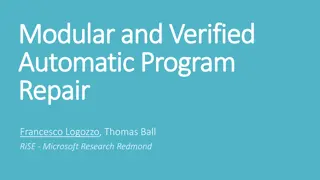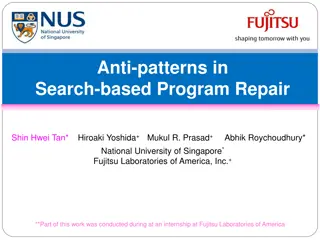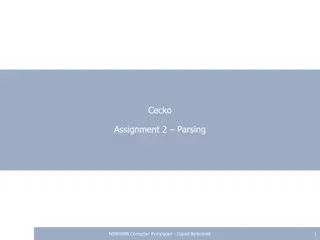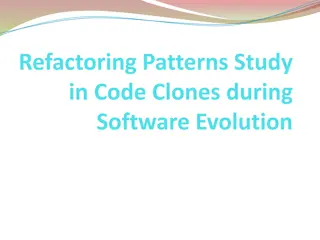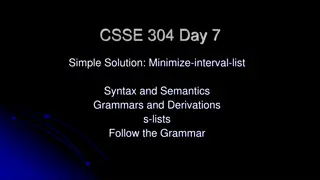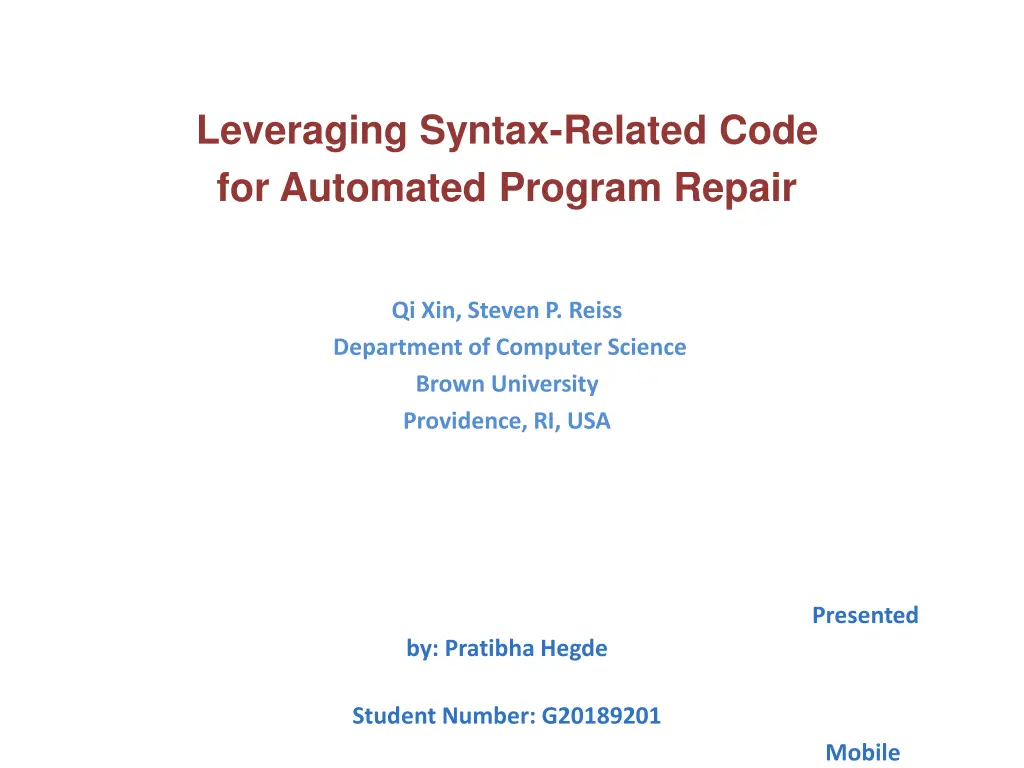
Leveraging Syntax-Related Code for Automated Program Repair
Presenting ssFix, an innovative automated program repair technique that leverages existing code fragments to produce patches for bug repair by performing syntactic code search. This technique identifies and utilizes repair code fragments from a codebase that are structurally and conceptually related to the faulty program, leading to effective bug fixes. Compared to other methods, ssFix focuses on syntax-related code fragments for efficient bug repair.
Download Presentation

Please find below an Image/Link to download the presentation.
The content on the website is provided AS IS for your information and personal use only. It may not be sold, licensed, or shared on other websites without obtaining consent from the author. If you encounter any issues during the download, it is possible that the publisher has removed the file from their server.
You are allowed to download the files provided on this website for personal or commercial use, subject to the condition that they are used lawfully. All files are the property of their respective owners.
The content on the website is provided AS IS for your information and personal use only. It may not be sold, licensed, or shared on other websites without obtaining consent from the author.
E N D
Presentation Transcript
Leveraging Syntax-Related Code for Automated Program Repair Qi Xin, Steven P. Reiss Department of Computer Science Brown University Providence, RI, USA Presented by: Pratibha Hegde Student Number: G20189201 Mobile Embedded System Laboratory
Abstract Introduction Overview Methodology Empirical Evaluation Related Work Conclusion
Abstract Presenting our automated program repair technique ssFix which leverages existing code (from a code database) that is syntax-related to the context of a bug to produce patches for its repair. Given a faulty program and a fault-exposing test suite, ssFix does fault localization to identify suspicious statements that are likely to be faulty. For each such statement, ssFix identifies a code chunk (or target chunk) including the statement and its local context. ssFix works on the target chunk to produce patches. To do so, it first performs syntactic code search to find candidate code chunks that are syntax-related, i.e., structurally similar and conceptually related, to the target chunk from a code database (or codebase) consisting of the local faulty program and an external code repository. ssFix assumes the correct fix to be contained in the candidate chunks, and it leverages each candidate chunk to produce patches for the target chunk. To do so, ssFix translates the candidate chunk by unifying the names used in the candidate chunk with those in the target chunk; matches the chunk components (expressions and statements) between the translated candidate chunk and the target chunk; and produces patches for the target chunk based on the syntactic differences that exist between the matched components and in the unmatched components. ssFix finally validates the patched programs generated against the test suite and reports the first one that passes the test suite.
Introduction A typical automated program repair technique accepts as input a faulty program and a fault-exposing test suite. As output, it produces patched programs that pass the test suite. One idea is to leverage existing code fragments to produce effective patches. We call the code fragments that contain the correct forms of expressions, statements, etc. And can be used for generating a correct patch the repair code fragments. GenProg assumes the faulty program itself contains the repair code fragments at the statement level for patch generation. Repair code fragments could possibly exist in the faulty program itself and/or in non- local programs. Then the problem is how to find and leverage such code fragments to produce patches. One idea is to use semantic code search, i.e., finding code fragments that are likely to be semantically correct. However, semantic code search is often expensive and it may fail to find many repair code fragments that do not represent the correct implementation, but can be leveraged to produce a correct patch.
We propose a novel repair technique ssFix which performs syntactic code search to find and leverage existing code fragments from a codebase to produce patches for bug repair. Repair code fragment that can be effectively leveraged for bug repair to be syntax- related (i.e., structurally similar and conceptually related) to the fault-located part of the faulty program. Such a repair code fragment is likely to implement a coding task similar to what is implemented in the faulty code fragment and implements it correctly. Compared to Search Repair and CP, ssFix is not directly targeted at finding code fragments that are semantically correct. Instead, ssFix uses a lightweight syntactic code search to find syntax-related code fragments where a repair code fragment is likely to exist. ssFix translates the code chunk by unifying the identifier names in it with those in the faulty code fragment (the target code chunk), matches the components between the two chunks, and produces patches for the target chunk based on the syntactic differences that exist between the matched components and in the unmatched components. For a candidate chunk that is syntax-related to the target chunk, the syntactic differences are small, and the search space is largely reduced.
In this paper , there are following instructions We developed a novel automated repair technique ssFix which performs syntactic code search to leverage existing code from a codebase to produce patches for bug repair. Evaluating ssFix on all the 357 bugs in the Defects4J dataset. Our results show that ssFix successfully repaired 20 bugs with valid patches generated. The median time for producing a patch is about 11 minutes. Compared to five other repair techniques for Java, our results show that ssFix has a better performance.
Overview ssFix accepts as input a faulty program, a fault-exposing test suite, and a codebase consisting of the faulty program and a code repository. 1) public static boolean isSameLocalTime(Calendar cal1,Calendar cal2){ 2) if (cal1 == null || cal2 == null) 3) { 3) throw new IllegalArgumentException( The date must not be null ); 4) } 5 ) return(cal1.get(Calendar.MILLISECOND)==cal2.get(Calendar.MILLISECOND)&& 6) cal1.get(Calendar.SECOND)==cal2.get(Calendar.SECOND) && 7) cal1.get(Calendar.MINUTE)==cal2.get(Calendar.MINUTE) && 8) cal1.get(Calendar.HOUR)==cal2.get(Calendar.HOUR) && 9) cal1.get(Calendar.DAY_OF_YEAR)==cal2.get(Calendar.DAY_OF_YEAR) && 10) cal1.get(Calendar.YEAR)==cal2.get(Calendar.YEAR) && 11) cal1.get(Calendar.ERA)==cal2.get(Calendar.ERA) && 12) cal1.getClass()==cal2.getClass()); 13) } Fig. 1. The faulty method of L21 (the fault is in red)
As output, ssFix either produces a patched program that passes the test suite or nothing if it cannot find one within a given time budget. ssFix goes through four stages to repair a bug: fault localization , code search , patch generation , and patch validation . For bug repair, the following modification should be made - cal1.get(Calendar.HOUR) == cal2.get(Calendar.HOUR) + cal1.get(Calendar.HOUR_OF_DAY) == cal2.get(Calendar.HOUR_OF_DAY) By leveraging existing code that is syntax-related to the bug context, ssFix successfully repaired the bug with the correct patch generated. A) Fault localization: ssFix employs the fault localization technique GZoltar (version 0.1.1) [17] to identify a list of suspicious statements in the program that are likely to be faulty. The statements in the list are ranked by their suspiciousness (measured as scores) from high to low. For bug repair, ssFix goes through the list: each time it looks at one statement (the target statement) and works on generating patches for a local code area (as a code chunk) including the statement.
Currently, ssFix can only produce patches that make local changes (i.e., within the local code chunk) in the faulty program, though this may involve modifying more than one statement. If the faulty program crashed with a stack trace printed, ssFix will first follow the stack trace to look at each statement in the stack trace first if the statement is from the faulty program. To repair a failure which causes the program to crash, assume the statements from the stack trace are more suspicious than the other statements in the faulty program. 1 GregorianCalendar calEnd = new GregorianCalendar(); 2 calEnd.setTimeInMillis(end.getTime()); 3 if (calStart.get(Calendar.HOUR_OF_DAY)==calEnd.get(Calendar. HOUR_OF_DAY) 4 && calStart.get(Calendar.MINUTE)==calEnd.get(Calendar.MINUTE) 5 && calStart.get(Calendar.SECOND)==calEnd.get(Calendar.SECOND) 6 && calStart.get(Calendar.MILLISECOND)==calEnd.get(Calendar. MILLISECOND) 7 && calStart.get(Calendar.HOUR_OF_DAY)==0 8 && calStart.get(Calendar.MINUTE)==0 9 && calStart.get(Calendar.SECOND)==0 10 && calStart.get(Calendar.MILLISECOND)==0 11 && start.before(end)) 12 return true; Fig. 2. A candidate code chunk retrieved from the Merobase repository (the fix expression is in purple). The chunk s enclosing method isAllDay checks whether the two time values obtained by start.getTime() (not shown) and end.getTime() both as millisecond values) represent the starting time of two days (from 00:00 of one day to 00:00 of the next day). The full class name of the chunk is org.compiere.util.TimeUtil.
B) Code Search: SsFix goes through three steps to find syntax-related code fragments from the codebase: target chunk identification , token extraction , and candidate retrieval . As the first step, ssFix generates a code chunk tchunk including the statement itself and possibly its context. ssFix then searches for code fragments in the codebase as cchunk s that are syntax- related, i.e., structurally similar and conceptually related, to tchunk . A tchunk to be used as the query for code search should not be too small (e.g., including only a simple statement as return x ) because it does not include enough context. On the other hand, it should also not be large.
As the second and third steps, ssFix extracts the structural k-gram tokens and the conceptual tokens from tchunk and invokes the Apache Lucene search engine [19] to do a document search to obtain a list of indexed code fragments (treated as documents) from the codebase. The retrieved list of code fragments (which we call the candidate code chunks, or cchunk s) are ranked from the ones that are the most syntax-related to tchunk to the least (measured by the scores computed by Lucene s default TF-IDF model from high to low). Later, ssFix goes through the list and leverages each cchunk to produce independent patches for tchunk . C) Patch generation: SsFix leverages a candidate chunk cchunk to produce patches for tchunk in three steps: candidate translation ,component matching , and modification . tchunk and cchunk may use different identifier names for variables, fields, types, and methods that are syntactically (and semantically) related. For example, the two chunks in Figure 1 and in Figure 2 use different names: cal2 and calEnd for a related variable.
As the first step, ssFix translates cchunk (if retrieved from a non-local program) by unifying the identifier names in cchunk with those that are syntactically related in tchunk . Without such a translation, ssFix would often fail to directly use statements and expressions from cchunk to produce patches for tchunk : the patched program could simply fail to compile for using unrecognized names. We developed an heuristic algorithm (Algorithm 2) which ssFix uses to match variables, fields, types, and methods between tchunk and cchunk based on how they are used in the two chunks. ssFix then renames the variables, fields, types, and methods in cchunk to their matched counterparts in tchunk to achieve the translation For our example, ssFix determines calStart to match cal1 and calEnd to match cal2 based on pattern-matched expressions like the following three pairs. cal1.get(Calendar.MILLISECOND) == cal2.get(Calendar.MILLISECOND) calStart.get(Calendar.MILLISECOND) == calEnd.get(Calendar.MILLISECOND) cal1.get(Calendar.SECOND) == cal2.get(Calendar.SECOND) calStart.get(Calendar.SECOND) == calEnd.get(Calendar.SECOND) cal1.get(Calendar.MINUTE) == cal2.get(Calendar.MINUTE) calStart.get(Calendar.MINUTE) == calEnd.get(Calendar.MINUTE)
Translated version of cchunk as rcchunk by renaming the two variables calStart and calEnd to their respective matched ones cal1 and cal2 in tchunk . rcchunk may not represent the correct patch but may contain the correct forms of components (expressions and statements) to be used in tchunk or indirectly suggest a faulty statement in tchunk to be deleted for producing a correct patch. Instead of replacing tchunk with rcchunk at the chunk level for patch generation, ssFix matches components that are syntactically related between the two chunks and produces patches based on the syntactic differences that exist between the matched components and in the unmatched components. Specifically, ssFix uses a modified version of the tree matching algorithm used by ChangeDistiller to do component matching, and it modifies tchunk to produce patches using three types operations: replacement , insertion , and deletion.
For our example, ssFix found the following pair of components (and 26 others) from tchunk and rcchunk to match. cal1.get(Calendar.HOUR) == cal2.get(Calendar.HOUR) cal1.get(Calendar.HOUR_OF_DAY) == cal2.get(Calendar.HOUR_OF_DAY) In tchunk , it then replaces the first component with the second (from rcchunk ) to produce the correct patch D) Patch Validation: ssFix produces a set of patches. It filters away patches that are syntactically redundant and patches that have been tested earlier . ssFix next sorts the filtered patches based on the modification types and the modification sizes to make a correct patch likely to be found before an over fitting patch. ssFix reports the first patched program that passes the test suite. If no such program can be found, ssFix looks at the next cchunk from the retrieved list and repeats the patch generation and patch validation processes.
Methodology A) Code Search: ssFix generates a local code chunk tchunk including s itself and possibly the local context of s . ssFix then extracts the structural and conceptual tokens from the text of tchunk .
1) Chunk generation. 2) Token Extraction. Extracting Structural Tokens: SsFix first tokenizes the text of a chunk and gets a list of tokens. To mask names, number constants, and literals that are program specific, ssFix symbolizes different types of tokens: ssFix uses the symbol $v$ for non-JDK variables and fields, $t$ for non-JDK & non- primitive types, $m$ for non-JDK methods, $lb$ for boolean literals (true or false ), $ln$ for number constants, and $ls$ for string literals that contain whitespace characters (e.g., as an exceptional message). ssFix does not symbolize JDK tokens, primitive types, character literals, or string literals that do not contain whitespace characters since they are often semantics-indicative. ssFix next splits the list of code pattern tokens into sub-lists by curly brackets and semicolons to avoid generating k-grams. Finally, ssFix concatenates (with no space in between) every sequential k (we set k=5) tokens within every sub-list of tokens to get the structural k-gram tokens. (Note that if a sub-list contains less than k tokens, ssFix would produce a less-than-kgram token.)
Given a statement as str.charAt(1)==e; where charAt is a JDK method, ssFix splits the statement into a list of tokens, symbolizes the tokens (changing str to $v$ and 1 to $ln$ ), splits the symbolized list into a sublist of tokens by semicolon, and finally gets a list of four 5- gram tokens: i.e { $v$.charAt($ln$ , .charAt($ln$) , charAt($ln$)== , ($ln$)== e } . Extracting the conceptual tokens: Two chunks that are conceptually related often use common tokens such as time , iterator , or buffer . ssFix extracts such conceptual tokens as follows: ssFix first tokenizes the text of a chunk and gets a list of tokens containing Java identifiers only. For any token that is camel-case or contains underscores or numbers, ssFix splits the token into smaller tokens and appends them to the list. ssFix finally changes each token in the list into lower-case and eliminates any tokens whose string lengths are less than 3 or greater than 32 as well as the stop words and the Java keywords.
For example, the list of conceptual tokens for str.getChars(0,strLen,buffer,size) is { str, getchars , chars , strlen , str , len , buffer , size } B) Patch Generation: ssFix leverages a candidate chunk cchunk to produce patches for tchunk in three steps: 1. Candidate Translation A candidate chunk cchunk and the target chunk tchunk may use different identifier names for variables, fields, types, and methods that are syntactically and semantically related, especially when they are not from the same program. 2. Component Matching : ssFix matches components between tchunk and rcchunk to identify their syntactic differences at the component level. Later it leverages the syntactic differences that exist between the matched components and in the unmatched components to produce patches for tchunk . 3. Modification: In the final step of patch generation, ssFix modifies tchunk based on the matched and unmatched components between tchunk and rcchunk to yield an initial set of patches using three types of modifications: replacement , insertion , and deletion .
Empirical Evaluation To evaluate the performance of ssFix, we used the Defects4J bug dataset (version 0.1.0) [25] which contains a set of 357 real bugs. We ask two research questions. 1) RQ1 : How many bugs can ssFix repair? What is the performance of ssFix on repairing these bugs? 2) RQ2 : Compared to other techniques, how effective is ssFix? 1) RQ1: We implemented ssFix and evaluated its performance on all 357 real bugs in the Defects4J bug dataset. Our results show that ssFix repaired 20 bugs with valid patches generated. The median time for generating a plausible patch is about 11 minutes. 1.1) Experimental Setup: a) Bug Dataset b) Ssfix Running Setup.
1.2) Results: Among the 60 plausible patches generated (for the 60 bugs), we determined 20 patches to be valid. Among the 20 valid patches, we determined 15 patches to be semantically equivalent to the developer patches associated with their repaired bugs, and 14 of the 15 patches to be not only semantically but also syntactically equivalent to the corresponding developer patches. In terms of passing the test suite without introducing regressions in general, we determined 5 patches to be valid though they are not semantically equivalent to the developer patches. Below is one such patch generated for the bug M57 : + double sum=0; (by developer) + float sum=0; (by ssFix) - int sum=0; Another challenge lies in ssFix s code search ability in finding effective candidates. The current way ssFix does code search is not effective for all cases. The bug Cl10 is one example. ssFix produces a target chunk as shown below. if (recurse) { - return allResultsMatch(n, MAY_BE_STRING_PREDICATE); + return anyResultsMatch(n, MAY_BE_STRING_PREDICATE); } else { return mayBeStringHelper(n); }
The candidate chunks found from the local program however do not contain the correct expression to be used for bug repair. So ssFix failed to repair the bug. The ways ssFix uses to do candidate translation, component matching, and modification can also limit ssFix from producing a valid/correct patch. But we found these are not actual problems when a target statement is accurately located and an effective candidate chunk is found. An inaccurate fault localization technique and an ineffective candidate could both lead to a defective patch being generated. 2) RQ2: We compared ssFix to five other repair techniques for Java: jGenProg [26], jKali [26], Nopol (version 2015) [29], HDRepair [30], and ACS [31] on the same dataset. Compared to these techniques, our results show that ssFix has a better performance: it produced larger numbers of patches that are valid and correct with the efficiency of producing a plausible patch being either comparable or better. 1.1) Experimental setup: We ran jGenProg, jKali, Nopol, HDRepair, and ACS each to repair all the 357 bugs in the Defects4J dataset on machines that have the same configurations with the ones on which we ran ssFix.
1.2) Results : Our results show that ssFix significantly outperforms jGenProg, jKali, and Nopol: ssFix produced many more valid patches (using either less or comparable time) than these techniques did. All the valid patches generated by these techniques were actually generated by ssFix. jGenProg cannot practically produce a correct patch when the repair statement does not exist in the faulty program.
Although ACS produced three valid patches that no other techniques produced, our results show that ssFix still outperforms ACS in terms of the number of valid patches generated and the repairing time. Since ACS is designed to repair bugs related to if-conditions, it is not easy for ACS to produce a direct, valid patch for bugs like L59 for which ssFix produced a correct patch by replacing a method argument strLen with another width. C) Discussion: The repair performance of ssFix significantly depends on the performance of code search, and we think there is still room for ssFix s code search to be improved. With a better code search, ssFix can be more efficient, and can produce more valid/correct patches and less over fitting patches.
Related Work ssFix leverages existing code fragments to produce patches for bug repair. SearchRepair [15] and CodePhage [14] are two repair techniques that are built on a similar idea. The main difference between ssFix and the two techniques lies in how they perform code search to find code for bug repair. ssFix uses syntactic code search while the two techniques use semantic code search (based on symbolic execution and constraint-solving, and program execution respectively).
Conclusion In this paper, we presented our automated repair technique ssFix which performs syntactic code search to find existing code from a code database that is syntax-related to the context of a bug and further leverages such code to produce patches for bug repair. Our experiments have demonstrated the effectiveness of ssFix in repairing real bugs. In the future, we will look at using different code search techniques on a larger code database for a potential performance enhancement.


